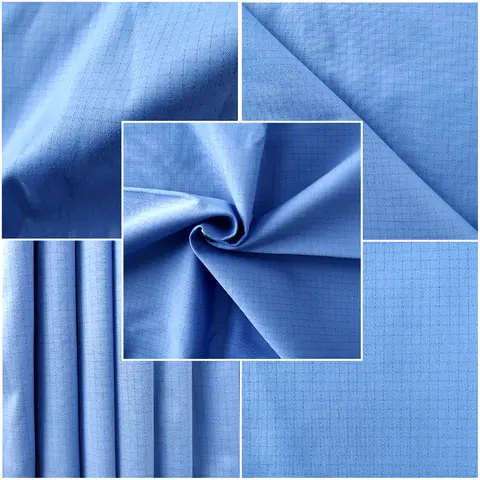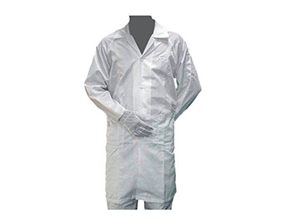Views: 0 Author: Site Editor Publish Time: 2025-03-12 Origin: Site








In the world of electronics manufacturing, assembly, and repair, electrostatic discharge (ESD) is one of the biggest threats to the integrity of sensitive electronic components. A small static shock can cause irreversible damage to integrated circuits, microchips, processors, and many other critical components, leading to product failures, expensive repairs, and significant downtime. To mitigate this risk, various protective materials and fabrics have been developed, two of the most common being ESD fabric and anti-static materials.
While these terms are often used interchangeably, they refer to different types of materials designed to control static electricity, and each serves a distinct function in preventing damage caused by electrostatic discharge. In this article, we’ll explore the differences between ESD fabric and anti-static materials, discuss their roles in static control, and provide a clear understanding of how they can be used in various environments.

Before diving into the comparison between ESD fabric and anti-static materials, it’s essential to understand the concept of electrostatic discharge (ESD) and why static control is crucial in the electronics industry.
Electrostatic discharge refers to the sudden flow of electricity between two objects with differing electrical potentials. ESD can occur when two objects come into contact and then separate, causing a discharge of static electricity. In an electronics manufacturing or assembly environment, workers, equipment, and even surfaces can accumulate static charges, which pose a risk when interacting with sensitive electronic components. Even the smallest amount of electrostatic charge can permanently damage microchips or circuit boards, making static control an essential part of the process.
ESD fabric is a specially designed textile that helps prevent the accumulation of electrostatic charges by dissipating them safely to the ground. It is made using conductive or dissipative fibers, such as carbon, metal, or carbon-based polymers, which allow the static electricity to be channeled away from sensitive components and safely grounded. ESD fabric is primarily used in environments where sensitive electronic components are handled, including electronics manufacturing, cleanrooms, and repair stations.
ESD fabric can take several forms, such as:
ESD Smocks and Garments: Clothing items like smocks, jackets, gloves, and aprons made from ESD fabric are commonly worn by workers handling sensitive electronics. These garments ensure that static buildup on a worker's body is dissipated before they interact with components.


ESD Wrist Straps: ESD wrist straps are worn by workers to continuously ground them, preventing the buildup of static on the body. These wrist straps are typically made from materials that contain conductive fibers, allowing static to flow safely away.
ESD Mats and Work Surfaces: ESD fabric is often used to create mats and workbenches that provide a static-free surface for assembly or repair tasks. These mats have conductive properties that help to ground static charges that might accumulate on tools, components, or workers.
The key characteristic of ESD fabric is its ability to dissipate static electricity, preventing the accumulation of dangerous charges that could damage sensitive components. These fabrics are designed to meet specific standards and are typically more effective in controlled environments where precise static control is required.
Leenol offers a range of high-quality ESD fabric solutions, ensuring comprehensive static protection across various work environments. As an "ESD TOTAL SOLUTION" company, Leenol manufactures products such as ESD smocks, wrist straps, and work surface mats, contributing to safer and more efficient electronic component handling.

Anti-static materials, on the other hand, are a broader category of materials designed to reduce or eliminate the buildup of static electricity. Leenol offers a range of anti-static products, including materials that are dissipative or insulative, depending on the intended purpose.
Dissipative Anti-Static Materials: These materials are designed to reduce the build-up of static electricity by allowing it to dissipate slowly over time. Leenol provides dissipative anti-static bags, clothing, and mats for less critical environments where complete static dissipation is not required.
Insulative Anti-Static Materials: Leenol also offers materials that resist the flow of electricity, which are used for applications where static buildup is not a concern.
Common anti-static materials include:
Anti-static bags: These are used for packaging electronic components for storage or transport. Leenol offers anti-static bags that provide a controlled environment to minimize static buildup.
Anti-static clothing: Although not as effective as ESD fabric, Leenol’s anti-static clothing helps reduce static buildup in certain situations.
Anti-static mats: Leenol also provides anti-static mats for general work surfaces where static buildup is less of a concern.
While both ESD fabric and anti-static materials are designed to manage static electricity, they differ in their functionality, performance, and application. Let’s break down the key differences:
Functionality
ESD Fabric: Leenol's ESD fabric is specifically designed to dissipate static electricity safely, preventing the accumulation of static charges on surfaces or workers' bodies. It allows static electricity to flow through it and be grounded, protecting sensitive electronic components.
Anti-Static Materials: Leenol's anti-static materials reduce or prevent static buildup but do not provide the same level of dissipation or grounding as ESD fabric.
Performance in Controlling Static
ESD Fabric: Leenol’s ESD fabrics are highly effective in controlled environments, such as assembly lines, cleanrooms, or workstations, where static charges need to be grounded.
Anti-Static Materials: Leenol’s anti-static materials are less effective at dissipating static charges. They reduce static buildup but are typically used for packaging and storage.
Applications and Use Cases
ESD Fabric: Leenol's ESD fabric is ideal for high-risk environments, including assembly lines, testing stations, and cleanrooms.
Anti-Static Materials: Leenol’s anti-static materials are more suitable for less sensitive environments such as packaging, storage, and low-risk work areas.
Cost and Investment
ESD Fabric: Leenol's ESD fabrics are generally more expensive than anti-static materials due to their comprehensive protection and long-term effectiveness.
Anti-Static Materials: Leenol's anti-static materials are more affordable but less effective at providing long-term protection.
Compliance and Industry Standards
ESD Fabric: Leenol's ESD fabrics meet stringent industry standards, such as ANSI/ESD S20.20 or IEC 61340-5-1, ensuring compliance and protecting sensitive components.
Anti-Static Materials: Leenol's anti-static materials may not meet the same strict standards and are better suited for lower-risk environments.
Leenol’s ESD fabric is the best choice for environments where sensitive electronic components are being handled, and there is a high risk of ESD damage. It is essential in cleanrooms, assembly lines, and repair stations where full protection against static discharge is necessary.
Leenol’s anti-static materials, on the other hand, are suitable for environments where static buildup is a concern but does not pose a significant risk to components. They are ideal for packaging, storage, and low-risk work environments.
Both ESD fabric and anti-static materials serve vital roles in static control, but they have different levels of effectiveness and are suited to different applications. Leenol's ESD fabric provides superior protection by dissipating static charges and preventing ESD damage to sensitive components, making it essential for high-precision manufacturing and assembly environments. Leenol's anti-static materials, on the other hand, are more suitable for less critical applications, such as packaging and storage, where reducing static buildup is important but full dissipation is not necessary.
For industries that demand high levels of static protection, such as electronics manufacturing, working with reliable suppliers like Leenol is essential. Specializing in ESD products and solutions, Leenol provides high-quality ESD fabrics and anti-static materials to ensure your workspace remains static-free and compliant with industry standards. Investing in the right ESD solution is crucial for protecting your components, improving product quality, and enhancing the overall efficiency of your operations.